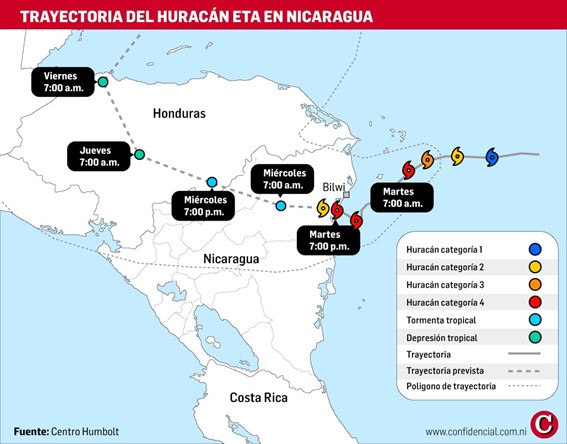Hurricane Eta Moves Across Nicaragua

Hurricane Eta downgraded to Tropical Storm and could reach Cuba and Florida. Warnings that the system is still dangerous even with decreasing winds, but heavy rain.
HAVANA TIMES – Two small-scale miners became the first fatalities Tuesday from the powerful hurricane Eta moving over Nicaragual. The storm made landfall as a category 4 hurricane with maximum sustained winds of up to 220 km/h. By Wednesday afternoon over land it was downgraded to a tropical storm, but warnings confirm that it is still life-threatening.
The miners died buried after a rain induced landslide in the artisanal mine they worked in Bonanza, in the North Caribbean Region. Eta hit the area with hurricane category 2 intensity on the Saffir-Simpson scale, out of a maximum of 5.
The deceased were only identified with the names of Will, 38 years old, and Norwin (39). The report came from relief authorities on “VOSTV” television channel, which shared the images.
A third miner, Lazarro Herrera (44), managed to survive the landslide and was the one who sounded the alarm.
They were warned, but…
The miners were working at the “El Comal” mine, in the community of Buena Vista. The landslide occurred as a result of the saturated soils due to the constant rains, Herrera explained, who suffered minor injuries.
“The landslide on the hill came and that’s what caught us. It actually grabbed all three of us. I managed to get out. I grabbed onto a tree and that’s why I came out alive,” he said.
He explained that prior to the event, representatives of a Governmental commission advised them not to work in the mines because hurricane Eta is causing heavy rains. However, they decided to do so in order to get money for their food.
While the survivor shared his testimony to the local media that covered the event, another landslide occurred at the same place, without consequences.
Saturated soils and river flooding
Eta, considered “extremely dangerous,” made landfall on the northeast coast of Nicaragua, in the Caribbean, one of the most vulnerable and impoverished areas of this Central American country, and inhabited mainly by afro-descendants and Miskito indigenous people.
Eta made landfall near Bilwi and was close to being upgraded to category 5 hurricane. It had winds at the coast of 250 km/h. It then lowered its intensity slightly when entering Nicaraguan territory.
This system is expected to go out to sea in the northwestern Honduras on Thursday night or Friday, after causing heavy rains with strong winds.
Civil Defense (SINAPRED) authority Guillermo Gonzalez reported on the destruction in a press conference. Among the damage are fallen poles with power and telecommunication lines, trees, as well as tin roofing blown off houses.
In addition, flooding in streets, soil saturation and flooding of rivers in communities of the North Atlantic Region. The swampy and sparsely populated area for its size (close to 500,000 people), is similar in size to El Salvador.
Evacuees launch SOS
Nicaraguan authorities assured that 30,000 citizens are in shelters at churches, schools and safe houses.
However, locals have told EFE that they had no information about the cyclone and were not alerted in time. Now they cry out for water, food, blankets and medicine, as well as plastic to protect themselves from the rains.
Eta became a “major” hurricane this Monday when it reached category 3 on the Saffir-Simpson hurricane scale and in a short time upgraded to 4, as it approached Nicaragua from the Caribbean.
Eta is the tenth hurricane to hit the Nicaraguan Caribbean coast in the last 13 years, and the second most destructive, only surpassed by Felix (2007), according to official records.
The path of Eta through Nicaragua
The eye of Hurricane Eta made landfall in Nicaraguan territory on Tuesday afternoon, November 3. According to the Humboldt Center, it entered 25 kilometers southeast of Bilwi, Puerto Cabezas, 12 kilometers to the north of the Haulover community.
The US National Hurricane Center reported that Eta had winds of 225 kilometers per hour and was moving inland at seven kilometers per hour.
Mario Baca of the Nicaraguan Institute for Territorial Studies (INETER), said Tuesday that once the eye of the hurricane makes landfall, it would begin to present a “weakening process,” which he said could be seen in the decrease in the speed of the winds.
“The trajectory indicates the tendency to continue from the Mining Triangle to “San Jose de Bocay” and the area eastern part of “Nueva Segovia” with the intensity of a tropical depression,” explained the specialist.
However, he noted “we could have significant rains in Nicaragua.” He predicted the center of the storm would leave for Honduras on Wednesday (November 4) in the late afternoon.





